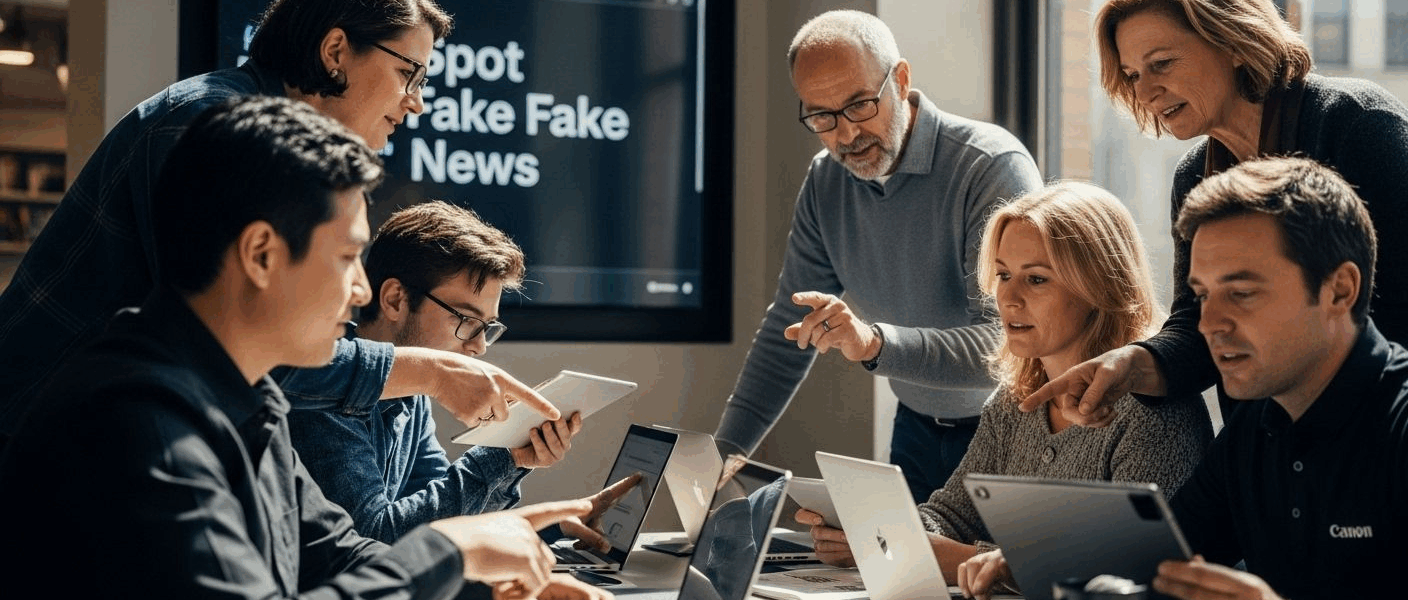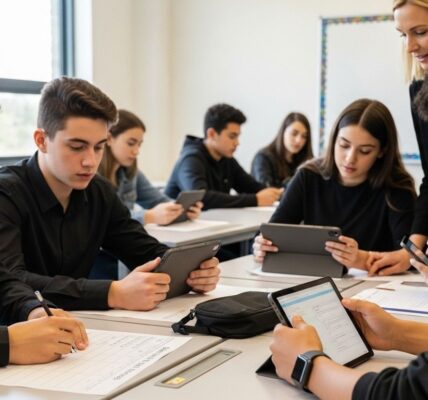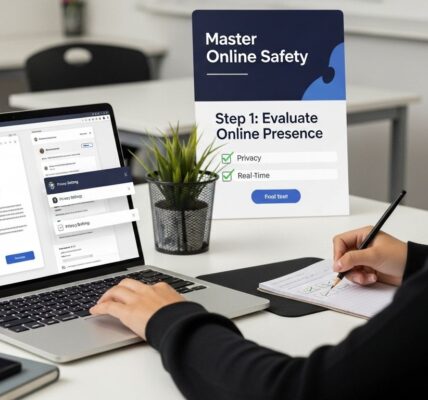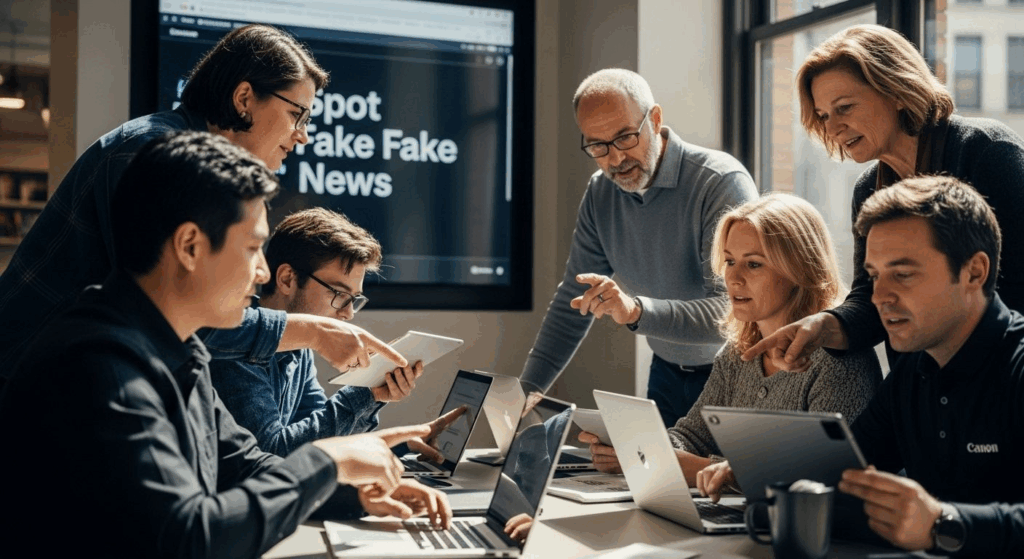
Fake news is everywhere and it is getting harder to spot the difference between real reporting and clever misinformation. Over 60 percent of Americans say they have trouble telling what is true online. That might make you think technology has made us hopelessly vulnerable. The real shock is that a few simple habits can make anyone nearly immune to fake news and most people have never learned them.
Table of Contents
- Recognizing Common Signs Of Fake News
- Fact-Checking News And Sources
- Evaluating Headlines And Images
- Helping Others Identify Fake News
Quick Summary
| Takeaway | Explanation |
|---|---|
| Pay attention to sensational headlines | Sensationalist headlines often aim to provoke emotions rather than inform. They can indicate potential fake news. |
| Verify source credibility before sharing | Always check the publication’s reputation, author’s credentials, and transparency to assess reliability. |
| Use fact-checking resources effectively | Utilize websites and tools designed for validating news to ensure the information is accurate and trustworthy. |
| Analyze images critically for manipulation | Images can be altered or taken out of context; use image verification tools to confirm authenticity. |
| Educate others about misinformation | Foster discussions on critical thinking and media literacy to help others recognize and combat fake news. |
Recognizing Common Signs of Fake News
Spotting fake news requires a strategic approach and critical thinking skills. While misinformation can be subtle, there are several key indicators that can help you distinguish between credible reporting and misleading content.
Headline Hysteria and Emotional Manipulation
One of the most prominent red flags in fake news is the sensationalist headline designed to provoke an emotional reaction. Research from Arizona State University suggests that many misleading articles use provocative, inflammatory language meant to trigger immediate emotional responses rather than provide balanced information. These headlines often capitalize on fear, anger, or outrage, using exaggerated claims or dramatic wording to draw readers in.
Fake news creators understand that emotional manipulation can short-circuit critical thinking. They craft titles that are intentionally shocking or controversial, hoping readers will share the content without actually reading or verifying the details. A study analyzing news content revealed that these articles frequently use simpler, more repetitive language in their body text, resembling satire more than genuine journalism.
Source Credibility and Author Verification
Checking the source and author of an article is crucial in determining its reliability. Experts from the College of Staten Island Library recommend thoroughly investigating the publication and its reputation. Legitimate news sources have established editorial standards, clear authorship, and transparent reporting processes. Fake news often originates from obscure websites, anonymous authors, or platforms with no journalistic credentials.
Look for several key indicators of source credibility: professional website design, clear contact information, verifiable author credentials, and a history of accurate reporting. Be skeptical of sources that lack transparency or have a history of publishing unsubstantiated claims. Learn more about identifying reliable news sources.
Contextual Red Flags and Verification Techniques
Beyond headlines and sources, multiple contextual elements can signal potential misinformation. Examine the publication date to ensure the information is current, as outdated content can be misleading. Check for supporting evidence, cross-reference claims with multiple reputable sources, and be wary of articles that make extraordinary claims without substantial proof.
Additionally, consider the article’s tone and writing style. Fake news often relies on absolute statements, lacks nuance, and avoids presenting balanced perspectives. Genuine journalism typically includes multiple viewpoints, provides context, and allows readers to draw their own conclusions. Developing a habit of critical reading and fact-checking can significantly reduce your chances of being misled by false information.
The following table summarizes common signs that an article might be fake news, as discussed in the section on recognizing misinformation. Use this as a quick reference when evaluating news content.
| Sign of Fake News | Description |
|---|---|
| Sensational/emotional headline | Headline is designed to provoke fear, anger, or outrage rather than inform |
| Exaggerated or dramatic wording | Uses claims or language that seem inflated or extreme |
| Lack of clear/authored source | Published by obscure platform or anonymous author with no credentials |
| Absence of balanced perspectives | Presents only one side of a story, avoids nuance or context |
| Outdated or misdated information | Article uses old or misleading dates to distort events |
| Predictable, repetitive language | Writing is overly simple, repetitive, and lacks professional tone |
| No verifiable supporting evidence | Article makes strong claims without citing credible sources or references |
Remember, spotting fake news is an active process that requires continuous learning and skepticism. By understanding these common signs and applying careful verification techniques, you can become a more informed and discerning news consumer.
Fact-Checking News and Sources
Navigating the complex world of information requires robust fact-checking strategies that go beyond surface-level analysis. Developing a systematic approach to verifying news sources can help you distinguish between credible reporting and potentially misleading content.
Utilizing Fact-Checking Websites and Tools
Professional fact-checking websites offer powerful resources for validating news stories and claims. Organizations like FactCheck.org and Snopes specialize in investigating viral claims and news stories, providing detailed analyses that break down the accuracy of information. These platforms employ professional researchers who meticulously examine sources, cross-reference claims, and provide comprehensive explanations of their findings.
Digital tools have also emerged to support fact-checking efforts. MediaBias/FactCheck provides detailed assessments of news sources, rating their political leanings and reliability. Such resources help readers understand potential biases and evaluate the credibility of different media outlets. Learn more about identifying reliable news sources.
Here’s a comparison of popular fact-checking resources and tools mentioned in the article, outlining their main functions and what they help you verify.
| Fact-Checking Resource | Main Function | Types of Content Covered |
|---|---|---|
| FactCheck.org | Investigates and analyzes news and claims for accuracy | News stories, political claims |
| Snopes | Debunks myths, rumors, and false stories | Viral stories, online rumors |
| MediaBias/FactCheck | Rates media outlets for bias and factual reporting | News sites, media sources |
| Google Reverse Image Search | Identifies image origins and manipulations | Photographs, graphics |
| TinEye | Traces the original use of images | Photos, manipulated images |
Cross-Referencing Multiple Reputable Sources
Effective fact-checking requires consulting multiple independent sources. When encountering a news story, compare reporting across different established media outlets. Credible news will typically have consistent core information, even if specific details or perspectives vary slightly. Look for sources with strong journalistic reputations that adhere to professional reporting standards.
Pay attention to the original sources cited within articles. Legitimate news reports will typically link to primary sources such as official reports, scientific studies, or direct statements from involved parties. Be wary of articles that make significant claims without providing verifiable references. Academic and government websites often provide authoritative information that can help confirm or challenge news narratives.
Advanced Verification Techniques
Advanced fact-checking involves more than just reading multiple sources. Use reverse image search tools to verify the authenticity of photos and graphics accompanying news stories. Websites like TinEye and Google Reverse Image Search can help determine whether images have been manipulated or taken out of context.
Develop a critical approach to interpreting news by understanding common misinformation tactics. This includes recognizing emotional manipulation, identifying logical fallacies, and understanding how context can be distorted. Professional fact-checkers recommend maintaining a healthy skepticism while remaining open to credible evidence.
Time is another crucial factor in fact-checking. Breaking news stories often lack complete information, so waiting for additional verified details can provide a more accurate understanding of events. Rushing to conclusions based on initial reports can lead to misunderstandings and the spread of potential misinformation.
Remember that fact-checking is an ongoing process. The information landscape constantly evolves, and staying informed requires continuous learning and critical thinking. By developing robust verification skills and using available tools, you can become a more discerning consumer of news and information.
Evaluating Headlines and Images
Visual information plays a critical role in how we consume and interpret news, making it essential to develop skills for critically analyzing headlines and images. Understanding the subtle manipulation techniques used in visual media can help you identify potential misinformation more effectively.
Headline Deconstruction Techniques
Headlines are designed to capture attention, but they can also be crafted to mislead readers. Research from the American Press Institute reveals that misleading headlines often use emotional triggers, exaggeration, or incomplete information to generate clicks. Look for specific warning signs such as all-capital letters, excessive punctuation, or sensationalist language that seems designed to provoke an emotional reaction rather than inform.
Effective headline analysis involves comparing the headline with the actual content of the article. Many fake news sources create deliberately misleading headlines that do not accurately represent the story’s details. Check if the headline makes claims that are not supported by the text, or if it uses provocative language that seems disconnected from the substantive information. Explore more about media literacy and news interpretation.
Image Verification and Manipulation Detection
Images can be powerful tools for misinformation, often manipulated to create false narratives or emotional responses. A study from Stanford University highlights that students and adults frequently struggle to distinguish between authentic and doctored images. Develop a systematic approach to image verification by using reverse image search tools like Google Images or TinEye to trace the original source and context of a photograph.
Look for telltale signs of image manipulation such as inconsistent lighting, unnatural shadows, pixelation around edited areas, or mismatched image resolutions. Professional fact-checkers recommend examining the metadata of images, which can provide information about when and where the image was originally created. Be particularly skeptical of images that seem designed to trigger strong emotional responses or support extreme political viewpoints.
Contextual Analysis of Visual Information
Understanding the broader context of visual media is crucial for accurate interpretation. Images can be deliberately taken out of context, recycled from previous events, or presented without critical background information. Professional journalists and fact-checkers emphasize the importance of tracing an image’s origin and understanding the full narrative surrounding its publication.
Consider the source of the image and the platform where it is being shared. Social media platforms are particularly prone to spreading manipulated or decontextualized images. Cross-reference visual information with multiple reputable sources, and be willing to spend time investigating the full story behind a compelling image or headline.
Remember that visual literacy is a skill that requires continuous learning and practice. By developing a critical and systematic approach to analyzing headlines and images, you can become more resilient against misinformation and make more informed judgments about the news you consume.
Helping Others Identify Fake News
Combating misinformation is a collective responsibility that requires active engagement and education. Empowering those around you to recognize and critically evaluate news sources can create a more informed and resilient community.
Educational Strategies and Communication Techniques
Research from the University of Cambridge suggests that direct, compassionate communication is most effective when helping others identify fake news. Approach conversations with empathy and curiosity rather than confrontation. People are more likely to be receptive to alternative perspectives when they feel respected and understood.
Develop practical teaching moments by asking questions that encourage critical thinking. Instead of simply declaring an article as false, guide others through the verification process. Ask questions like “What makes you believe this source?” or “Have you checked other reliable sources?” This approach helps individuals develop their own fact-checking skills. Learn more about effective media literacy techniques.
Social Media and Community Awareness
A study by the Pew Research Center highlights the critical role of social networks in spreading and combating misinformation. When you encounter potentially false information shared by friends or family, respond constructively. Share credible sources that provide context or accurate information, and explain why the original post might be misleading.
Encourage digital literacy within your social circles. Many people are unaware of the sophisticated techniques used to spread misinformation. Offer to help friends and family learn fact-checking techniques, demonstrating tools like reverse image search, fact-checking websites, and source verification methods. Create a supportive environment where questioning information is seen as a positive skill rather than a confrontational act.
Long-Term Approaches to Misinformation Prevention
Building resilience against fake news requires a comprehensive approach that goes beyond individual interactions. Support educational initiatives that teach critical thinking and media literacy in schools and community centers. These programs can provide foundational skills for identifying and evaluating information sources.
Recognize that combating misinformation is an ongoing process. Stay patient and consistent in your approach. Not every conversation will immediately change someone’s perspective, but each interaction contributes to a broader understanding of information literacy. Share your own experiences of learning to identify fake news, demonstrating that critical thinking is a skill anyone can develop.
Remember that helping others identify fake news is about empowerment, not judgment. By approaching the topic with compassion, curiosity, and practical guidance, you can help build a more informed and discerning community. The goal is not to prove someone wrong, but to support their ability to navigate the complex information landscape more effectively.
Contextual Analysis of Visual Information
Understanding the broader context of visual media is crucial for accurate interpretation. Images can be deliberately taken out of context, recycled from previous events, or presented without critical background information. Professional journalists and fact-checkers emphasize the importance of tracing an image’s origin and understanding the full narrative surrounding its publication.
Consider the source of the image and the platform where it is being shared. Social media platforms are particularly prone to spreading manipulated or decontextualized images. Cross-reference visual information with multiple reputable sources, and be willing to spend time investigating the full story behind a compelling image or headline.
Remember that visual literacy is a skill that requires continuous learning and practice. By developing a critical and systematic approach to analyzing headlines and images, you can become more resilient against misinformation and make more informed judgments about the news you consume.
Helping Others Identify Fake News
Combating misinformation is a collective responsibility that requires active engagement and education. Empowering those around you to recognize and critically evaluate news sources can create a more informed and resilient community.
Educational Strategies and Communication Techniques
Research from the University of Cambridge suggests that direct, compassionate communication is most effective when helping others identify fake news. Approach conversations with empathy and curiosity rather than confrontation. People are more likely to be receptive to alternative perspectives when they feel respected and understood.
Develop practical teaching moments by asking questions that encourage critical thinking. Instead of simply declaring an article as false, guide others through the verification process. Ask questions like “What makes you believe this source?” or “Have you checked other reliable sources?” This approach helps individuals develop their own fact-checking skills. Learn more about effective media literacy techniques.
Social Media and Community Awareness
A study by the Pew Research Center highlights the critical role of social networks in spreading and combating misinformation. When you encounter potentially false information shared by friends or family, respond constructively. Share credible sources that provide context or accurate information, and explain why the original post might be misleading.
Encourage digital literacy within your social circles. Many people are unaware of the sophisticated techniques used to spread misinformation. Offer to help friends and family learn fact-checking techniques, demonstrating tools like reverse image search, fact-checking websites, and source verification methods. Create a supportive environment where questioning information is seen as a positive skill rather than a confrontational act.
Long-Term Approaches to Misinformation Prevention
Building resilience against fake news requires a comprehensive approach that goes beyond individual interactions. Support educational initiatives that teach critical thinking and media literacy in schools and community centers. These programs can provide foundational skills for identifying and evaluating information sources.
Recognize that combating misinformation is an ongoing process. Stay patient and consistent in your approach. Not every conversation will immediately change someone’s perspective, but each interaction contributes to a broader understanding of information literacy. Share your own experiences of learning to identify fake news, demonstrating that critical thinking is a skill anyone can develop.
Remember that helping others identify fake news is about empowerment, not judgment. By approaching the topic with compassion, curiosity, and practical guidance, you can help build a more informed and discerning community. The goal is not to prove someone wrong, but to support their ability to navigate the complex information landscape more effectively.
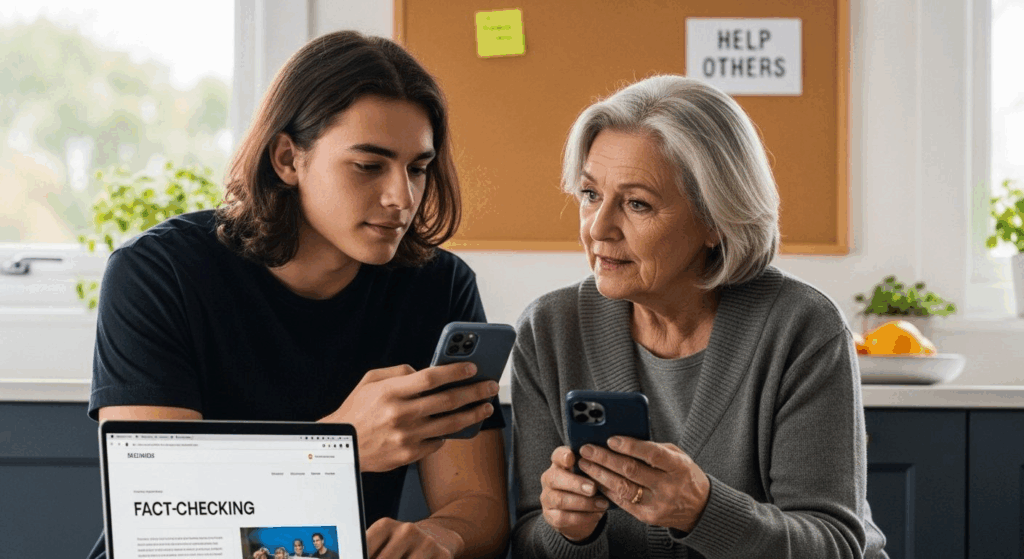
Frequently Asked Questions
What are the common signs of fake news?
Common signs of fake news include sensational or emotional headlines, lack of credible sources, exaggerated claims, and absence of balanced perspectives. Additionally, outdated information and articles without supporting evidence can also indicate misinformation.
How can I verify the credibility of a news source?
To verify a news source’s credibility, check the publication’s reputation, author credentials, and transparency. Look for established editorial standards, professional website design, and clear contact information. Additionally, cross-reference the information with multiple reputable sources.
What are some reliable fact-checking websites I can use?
Some reliable fact-checking websites include FactCheck.org, Snopes, and MediaBias/FactCheck. These platforms provide analyses of news stories and claims, helping you determine their accuracy and potential biases.
How can I help others identify fake news?
To help others identify fake news, engage in compassionate, respectful conversations and ask questions that encourage critical thinking. Share credible sources and provide practical examples of fact-checking techniques, helping them understand how to evaluate information effectively.
Ready to Outsmart Fake News and Stay Informed?
Every day you face uncertainty about which news you can trust. Headlines push for your reaction, images are manipulated to grab your attention, and even credible sources can be hard to confirm. If you are tired of guessing and want to feel secure about the information you share and consume, there is a way forward. Ultra News recognizes your concerns about emotional manipulation, source credibility, and the frustration of digging for the truth.
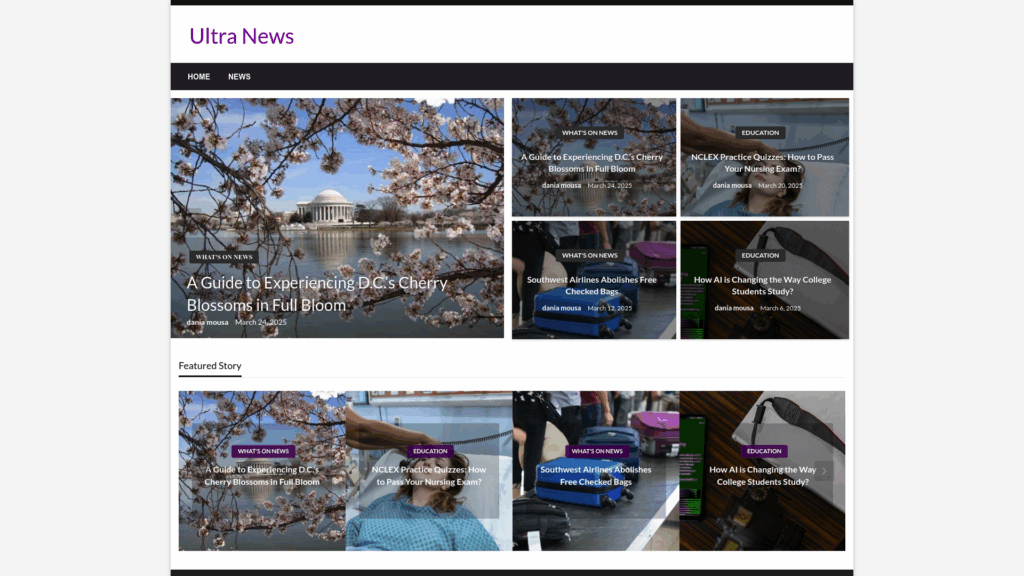
Start building your news literacy and confidence today. Visit Ultra News for expertly curated updates, practical tips, and clear educational guides designed to empower you. Dive deeper with resources like our types of news sources explained guide and discover more tools to help you verify information, break through misinformation, and protect your peace of mind. Take control of your news experience—explore Ultra News now to keep yourself and your community reliably informed.
